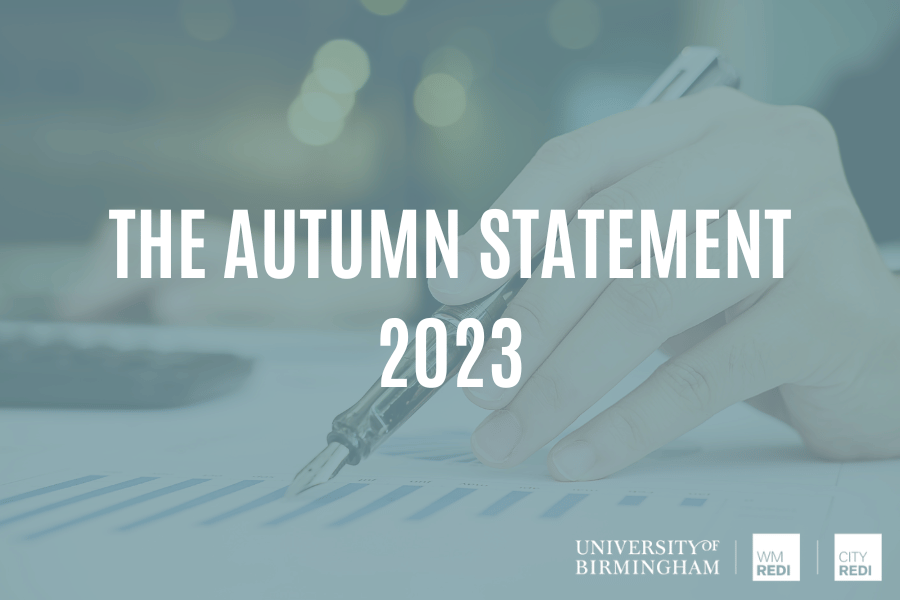Alice Pugh looks at the OBR Economic Fiscal Outlook and breaks down the Chancellor's Autumn Statement announcement from yesterday.
On the day of the budget economic forecasts for the next 5 years are released by the Office for Budget Responsibility (OBR). These forecasts are important as they show the impact that the new Autumn statement will have in the near, medium and long term. The main findings in the OBR report on this budget have been:
The economy recovered more fully from the pandemic and weathered the energy price shock better than anticipated.
By the middle of this year, the level of real GDP stood nearly 2% above its pre-pandemic level and around 3% above the March forecast. But we now expect the economy to grow more slowly over the forecast period, leaving the level of real GDP only 0.5% higher in the medium term than in the March forecast. On an annual basis, real GDP growth slows from 4.3% in 2022 to 0.6% this year and 0.7% next year. The Medium-term potential growth rate of the economy is expected to be 1.6%, largely driven by a weaker forecast for average hours per worker. Reflecting the effect of demographic shifts in the composition of the working population, towards younger and older age groups which work shorter hours.
Inflation to remain higher for longer, taking until the second quarter of 2025 to return to the 2 per cent target, more than a year later than forecast in March.
Inflation is expected to be more persistent and domestically fuelled than previously anticipated, falling below 5% by the end of the year but not returning to the target rate of 2% until the start of 2025.
More persistent inflation means markets expect interest rates to be more than a full percentage point higher than assumed in March.
Markets now expect interest rates will need to remain higher for longer to bring inflation under control. Despite the more challenging outlook for the real economy, higher inflation leaves nominal GDP nearly 5½ per cent higher by the start of 2028 than we forecast in March.
Living standards, as measured by real household disposable income (RHDI) per person, are forecast to be 3.5% lower in 2024-25 than their pre-pandemic level.
This represents the largest reduction in real living standards since ONS records began in the 1950s, with EHDI not expected to recover to its pre-pandemic level till 2027-28. OBR does estimate that the reduction in the rate of National Insurance Contributions (NICs) announced in this statement will boost real household incomes by 0.5% by the end of the 2028 forecast.

The Chancellor spends almost all of the pre-measures forecast improvement in borrowing between 2023-24 and 2027-28 on his Autumn statement measures, leaving post-measures borrowing largely unchanged.
Policy measures announced since the March forecast raise borrowing every year and by £26.6 billion in 2027-28, which includes:
- a significant reduction in rates of National Insurance Contributions (NICs), including a 2p cut in the main rate of employee NICs, which costs £10.4 billion by 2027-28;
- a permanent 100 per cent capital allowance for qualifying business investment (known as ‘full-expensing’) which costs £9.1 billion in 2027-28;
- a package of reforms to welfare and health services designed to increase labour market participation which save £0.6 billion, wider changes to public spending which cost £8.2 billion, and a set of other tax decisions which raise revenue by £2.0 billion, in 2027-28; and
- the indirect effects of these and other policies on the economy, which boost demand in the near term and labour supply and business investment in the medium term, adding a further £1.5 billion to borrowing in 2027-28 as higher debt interest spending (£3.6 billion) outweighs reductions from other economic effects (£2.1 billion).
Key Announcements within the Autumn Statement
The following are the key announcements that were made in the Autumn Statement 2023:
Taxation and Wages
- National Insurance–
- Cut from 12% to 10% from January 2024
- Class 2 National Insurance for self-employed people earning more than £12,570 was abolished.
- Class 4 National Insurance for self-employed – paid on profits between £12,570 and £50,270 – cut from 9% to 8% from April.
- National living Wage-
- The National Living wage increased to £11.44 from £10.42 per hour from April 2024.
- The national living wage will be expended to include 21- and 22-year-olds, rather than those 23 and over.
Benefits and Pensions
- Universal Credit and other working-age benefits – will increase by the September inflation rate by 6.7%.
- Local Housing Allowance Rates – which determine the level of housing benefit and Universal Credit people receive to pay rent in Great Britain – to be unfrozen and increased to 30% of local rents.
- Work Capability Assessment – to be reformed to reflect the availability of home working after the COVID-19 pandemic.
- Funding for inactive workforce
- Funding of £1.3bn over the next five years to help people with health conditions find jobs.
- Further £1.3bn to help people who have been unemployed for over a year.
- Benefits Claimants – Claimants in England and Wales deemed able to work but who refuse to seek employment lose access to their benefits and extras like free prescriptions.
- State Pension Payments – to increase by 8.5% from April, in line with average earnings.

Business and Infrastructure
- ‘Full expensing’ tax breaks – allowing companies to deduct spending on new machinery and equipment from profits – made permanent.
- Business Rates – the 75% business rates discount for retail, hospitality and leisure firms in England extended for another year.
- Households living close to infrastructure – Households living near infrastructure such as new pylons and transmission infrastructure get up to £1,000 a year off energy bills for a decade.
- Attracting Investment – Funding of £4.5bn to attract investment to strategic manufacturing sectors, including green energy, aerospace, life sciences and zero-emission vehicles.
- Artificial Intelligence Centres – £500m in funding over the next two years to fund Artificial Intelligence Centres.
- Investment Zones and Freeports – Financial incentives for investment zones and tax reliefs for freeports extended from five years to 10 years, with new investment zones announced for the West Midlands, East Midlands and Greater Manchester, as well as Wrexham and Flintshire.
Other Measures
- Alcohol Duty – on all alcohol frozen until 1 August next year.
- Duty Rate on Tobacco products – increases by 2% above RPI inflation; hand-rolling tobacco rises 12% above RPI.
Overall, the Autumn Budget was relatively sparse, this is likely because the government will be hoping to save its more exciting announcements till the April Statement next year, as the last statement before the general election. However, as the OBR has pointed out the government has largely spent almost all of the pre-measures forecast improvement in borrowing between 2023-24 and 2027-28 on his Autumn statement measures, so there will be likely less manoeuvrability in spending in the next budget.
This blog was written by Alice Pugh, Policy and Data Analyst, City-REDI / WMREDI, University of Birmingham.
Disclaimer:
The views expressed in this analysis post are those of the authors and not necessarily those of City-REDI, WMREDI or the University of Birmingham.

